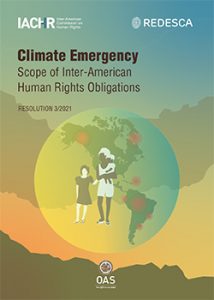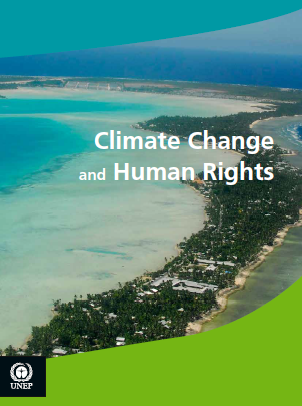By Pedro Cisterna-Gaete and Maria Antonia Tigre
In March 2022, the Inter-American Commission on Human Rights (IACHR) and the Office of the Special Rapporteur on Economic, Social, Cultural and Environmental Rights (REDESCA) jointly published Resolution No. 3/21, entitled Climate Emergency: Scope of Inter-American human rights obligations. The resolution’s purpose is to systematize the human rights obligations of States in the context of the climate crisis to ensure that public policy decisions are made according to a rights-based approach. The resolution represents the first resolution of the Inter-American System of Human Rights (IASHR) dedicated explicitly to the issue of climate change. The IASHR is principally made up of both the IACHR and the Inter-American Court of Human Rights (IACtHR), as well as other bodies focused on particular rights or groups. This blog post highlights takeaways from the resolution and its significance for climate litigation.
In September 2019, the IACHR held a hearing for civil society organizations who called on the IASHR to recognize the climate crisis, imploring nations in the region to take further and substantive steps to address climate change. These organizations published a report on the petition and recommended that the IASHR should request states to take a rights-based approach to the climate crisis. The resolution builds on this report and the Advisory Opinion No. 23/17 of the IACtHR, which elaborated the human right to a healthy environment and recognized it as an autonomous and justiciable human right by the IASHR (see here).
Substantive rights
The resolution acknowledges that the nexus between climate change and human rights is increasingly evident, noting the consensus established in climate change and international human rights regimes. In particular, the resolution notes recent developments in environmental rights, including the entry into force of the Escazú Agreement (see here and here), a treaty for advancing environmental procedural and justice rights in Latin America, and the adoption of Human Rights Council Resolution 48/13, recognizing the right to a healthy environment (see here).
The resolution recognizes that climate change is a human rights emergency, constituting one of the greatest threats to the full enjoyment of human rights by present and future generations, to the health of ecosystems and all species that inhabit the hemisphere. The publication of the resolution is timely. The Intergovernmental Panel on Climate Change (IPCC) recently released its latest report, highlighting that human-induced climate change is causing dangerous and widespread disruption in nature, affecting the lives of billions of people living in highly vulnerable contexts, including those in Central and South America.
The resolution notes that climate impacts are a significant threat to the enjoyment of a wide range of rights, including the right to life, food, housing, health, water, and the right to a healthy environment. The Commission explicitly states that climate change directly affects the right to a healthy environment, building on the Advisory Opinion No. 23/17 and Lhaka Honhat v. Argentina (see more here). Therefore, the resolution aims to ensure that the implementation, design, and execution of States’ climate actions have the appropriate rights-based approach. The text includes a series of standards and recommendations addressed to the member States of the Organizations of American States (OAS), which are also relevant to non-state actors working in the region. For example, the resolution calls on States to take appropriate measures to mitigate GHGs, implement adaptation measures, and remedy the resulting damages.
Procedural rights
The resolution reinforces the Escazú Agreement’s procedural rights guarantees. The resolution calls on States to “ensure that climate norms, policies and actions are constructed, updated and/or reexamined in a transparent and participatory manner,” illustrating the importance of environmental democracy in tackling climate change. The resolution argues that reinforcing the rights of access to information, public participation and justice “is an accelerator of climate action in the region and enhances the fulfillment of the substantial obligations of States.”
Also reinforcing Escazú, the resolution recognizes the rights of environmental defenders, calling states to avoid harassment, stigmatization, and discrimination against them. In addition, attacks or threats against environmental defenders must be “effectively” investigated. The resolution is also clear in recognizing and requiring the customary international law duty to conduct an environmental impact assessment (EIA) where potential environmental harms are significant, stating that “social and environmental impact studies” are necessary in accordance with the principle of due diligence. Relatedly, the “right to prior consultation” is implicated in cases where indigenous people are “seeking free, prior and informed consent.”
Impact on climate litigation
The resolution has the potential to have a significant impact on both pending and future climate litigation petitions within the IASHR. Climate litigation in the region goes back nearly two decades – the 2005 Inuit petition to the Inter-American Commission (IACHR), which was dismissed, is widely considered the first rights-based climate case. Two notable climate litigation cases, the 2013 Athabaskan petition and the 2021 Cité Soleil petition, are still pending.
The resolution calls on States to comply with standards of climate action that particularly protect the rights of the most vulnerable, which could encourage climate claims. The resolution stresses the differentiated impact of climate change on vulnerable groups regarding the effective enjoyment of their rights. It specifies that those living in ‘poverty, extreme poverty, homelessness or living in informal settlements’ are more exposed to the long-term impacts of climate change. Current State policies are failing to protect many – in Latin America, there are 86 million people living in extreme poverty and are highly vulnerable to the effects of climate change. The resolution’s emphasis on protection of the most vulnerable could encourage new claims questioning the adequacy of current policies of States to protect those groups.
The resolution also calls on countries to “move towards a clean and just energy transition.” Several countries in the OAS have committed to increased use of clean energy in their Nationally Determined Contributions (NDCs) to the Paris Agreement. The transition towards clean energy implies the closure of polluting industries, affecting thousands of jobs in the region. This transition has already led to climate litigation. For instance, the Chilean Supreme Court in Company Workers Union of Maritima & Commercial Somarco Limited and Others v Ministry of Energy required the State of Chile, in achieving carbon neutrality, to adopt a just transition strategy for the workers harmed by the loss of their direct and indirect source of employment and for the communities affected by the transition. The impacts of the energy transition are likely to lead to further cases. The resolution’s language on requiring sustainable and participatory processes for achieving a just transition can serve as a guideline to states and courts in these cases.
Climate claims brought by indigenous groups may also be bolstered by the resolution. For instance, the resolution establishes the obligation to “delimit and demarcate the collective ancestral territory,” where states should avoid “granting concessions for projects” without consultation and consent (para. 47). Substantive and procedural indigenous rights in Latin America are often ignored by authorities in deciding whether to approve development projects. For instance, the Tapajos project in the Amazon could flood 780 square kilometers of protected land for indigenous communities. Climate claims challenging these types of decisions may look to cite to paragraph 47 of the resolution to support their claims.
Litigation citing the obligations of companies, especially those from the fossil fuel and factory farming industries, to respond to climate change may be bolstered by the resolution. The resolution requires these companies to ‘adjust their behaviour and operations to the norms of the business and human rights regime’(para. 42). In addition, companies must ‘adopt plans to reduce GHG emissions’ and make them public (para. 44). This obligation to adopt mitigation plans covers not only products and services but also subsidiaries and suppliers. Litigants may bring claims against companies in Latin America arguing that they must uphold these obligations to comply with IASHR human rights standards. Additionally, companies abroad that have subsidiaries in Latin American could be obliged to develop plans to mitigate emissions and make them public, and litigants may bring them to court if they fail to do so.
Finally, this resolution contributes to a more precise definition of climate obligations of OAS governments. Resolutions like this one contribute to ‘concretizing’ the climate obligations of states, by “identifying benchmarks to assess state actions and giving national courts tools to scrutinize those activities.” In the growing body of climate litigation in the OAS region, courts can draw on the resolution as a tool to scrutinize the adequacy of climate action by governments and companies.
* This blog post is part of the Sabin Center’s Peer Review Network of Global Climate Litigation and was edited by Maria Antonia Tigre and Korey Silverman-Roati. Mr. Cisterna-Gaete is the rapporteur for the Inter-American System of Human Rights.
Dr. Maria Antonia Tigre is the Global Climate Litigation Fellow at the Sabin Center for Climate Change Law at Columbia Law School.





